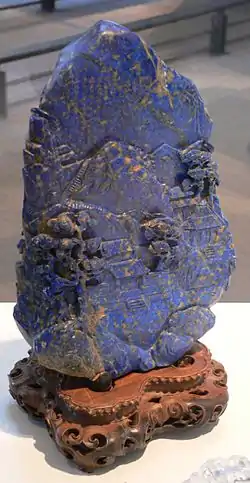瑠璃
Chinese
| For pronunciation and definitions of 瑠璃 – see 琉璃 (“a kind of blue and translucent natural precious stone, probably lapis lazuli; etc.”). (This term is a variant form of 琉璃). |
Japanese
| Kanji in this term | |
|---|---|
| 瑠 | 璃 |
| る Grade: S |
り Grade: S |
| goon | on’yomi |
| Alternative spelling |
|---|
| 琉璃 |

Etymology
Shortened from 吠瑠璃 (beiruri), itself from Middle Chinese 吠瑠璃 (MC bjojH lje), a phonetic transcription of Sanskrit वैडूर्य (vaiḍūrya, “cat's eye, beryl”).[1][2] Some scholars suggest that the source term might instead have been Pali veḷuriya (“precious stone, maybe lapis lazuli”).[3][4]
Pronunciation
Noun
瑠璃 • (ruri)
- lapis lazuli
- the deep blue color of lapis lazuli: azure
- common name for various blue thrushes (birds) in family Muscicapidae, such as the 大瑠璃 (ōruri, “blue and white flycatcher, Cyanoptila cyanomelana”) or 小瑠璃 (koruri, “Siberian blue robin, Larvivora cyane, syn. Luscinia cyane”)
- (mineralogy, geology) lazurite
- Synonym: 青金石 (seikinseki) (more specific)
Idioms
Idioms
- 瑠璃の光も磨きがら (ruri no hikari mo migakigara): “lapis lazuli's shine is brought out by polishing” → inborn talent is no substitute for hard work and practice
- 瑠璃も玻璃も照らせば光かる (ruri mo hari mo teraseba hikaru): “lazuli and crystal sparkle when you shine a light on them” → even if two things are different, illumination can make their excellent qualities clear
- 瑠璃も玻璃も照らせば分かる (ruri mo hari mo teraseba wakaru): “you can tell lazuli and crystal by shining a light on them” → the true nature of similar things can be discerned by different means or in different situations
- 瑠璃は脆し (ruri wa moroshi): “lazuli is fragile” → a metaphor for the fragility of beautiful things
- 瑠璃も曇る (ruri mo kumoru): “even lazuli gets cloudy” → a metaphor for how even the most excellent things lose value over time
Derived terms
Derived terms
- 瑠璃色 (rurīro): azure blue
- 瑠璃貝 (rurigai): pelagic marine snails of genus Janthina
- 瑠璃懸巣 (ruri kakesu): a jaybird, Lidth's jay (Garrulus lidthi)
- 瑠璃瓦 (rurigawara): a kawara tile with a glossy blue glaze, commonly used in roofing in Japan
- 瑠璃観音 (Ruri Kannon): one of the 33 manifestations of Kannon (観音), the Buddha or goddess of mercy, depicted standing on a lotus leaf floating in the water, with incense in her right hand and a lotus blossom in her left hand
- 瑠璃釉 (rurigusuri): a slip containing powdered cobalt and applied to ceramics to achieve a deep blue color after firing
- 瑠璃光如来 (Rurikō Nyorai): another name for 薬師如来 (Yakushi Nyorai), the medicine Buddha
- 瑠璃紺 (ruri kon): a deep blue and glossy piece of lapis lazuli; a deep blue color, the color of lapis lazuli
- 瑠璃小灰 (ruri shijimi): holly blue butterfly (Celastrina argiolus)
- 瑠璃草 (ruri sō): navelwort: a flowering plant of genus Omphalodes in family Boraginaceae, native to the mountainous regions of Honshū and Hokkaidō; alternate name for related plant 蛍葛 (hotaru kazura) (Lithospermum zollingeri)
- 瑠璃蛺 (ruri tateha): blue admiral butterfly (Kaniska canace)
- 瑠璃鳥 (ruri chō): Taiwan whistling thrush or Formosan whistling thrush (Myophonus insularis)
- 瑠璃灯 (ruri tō): a kind of hexagonal lamp used in the Ōbaku sect of Zen, covered in thin silk and containing a candela made of lapis lazuli, and hung in the main hall of temples
- 瑠璃虎の尾 (ruri tora no o): “azure tiger's tail” (Veronica subsessilis)
- 瑠璃繁縷 (ruri hakobe): poor man's weatherglass (Lysimachia foemina, syn. Anagallis foemina), a low-growing herbaceous annual plant
- 瑠璃鶲 (ruribitaki): red-flanked bluetail, orange-flanked bush-robin, or Siberian bluechat (Tarsiger cyanurus)
- 瑠璃溝隠 (ruri mizokakushi): a flowering herbaceous perennial plant, the edging lobelia, garden lobelia or trailing lobelia (Lobelia erinus)
- 瑠璃実の樹 (ruri mi no ki): an evergreen shrub of genus Lasianthus, native to the Izu Peninsula
- 瑠璃ムスカリ (ruri musukari): azure muscari, a perennial bulbous plants native to Eurasia, of genus Muscari
- 瑠璃柳 (ruri yanagi): waxy-leaf nightshade, a flowering shrub (Solanum glaucophyllum, syn. of Solanum melanoxylon)
Synonyms
- (lazurite): 青金石 (seikinseki)
References
- Shōgaku Tosho (1988) 国語大辞典(新装版) [Unabridged Dictionary of Japanese (Revised Edition)] (in Japanese), Tōkyō: Shogakukan, →ISBN
- Matsumura, Akira, editor (2006), 大辞林 [Daijirin] (in Japanese), Third edition, Tōkyō: Sanseidō, →ISBN
- 1985, The Golden Peaches of Samarkand, Edward H Schafer, University of California Press, Los Angeles, 398 pp.
- 1917, Field Museum of Natural History: 1909, “The Beginnings of Porcelain in China”, Berthold Laufer and Henry Windsor Nichols, The Museum, p138:
- The glassy paste for the production of ceramic glazes was called liu-li 琉璃 (in the Han Annals 流離) or p'i-liu-li, derived from Prākrit veluriya, Mahārāshṭrī verulia (Sanskrit vaiḍūrya).
- NHK Broadcasting Culture Research Institute, editor (1998), NHK日本語発音アクセント辞典 [NHK Japanese Pronunciation Accent Dictionary] (in Japanese), Tōkyō: NHK Publishing, →ISBN
This article is issued from Wiktionary. The text is licensed under Creative Commons - Attribution - Sharealike. Additional terms may apply for the media files.